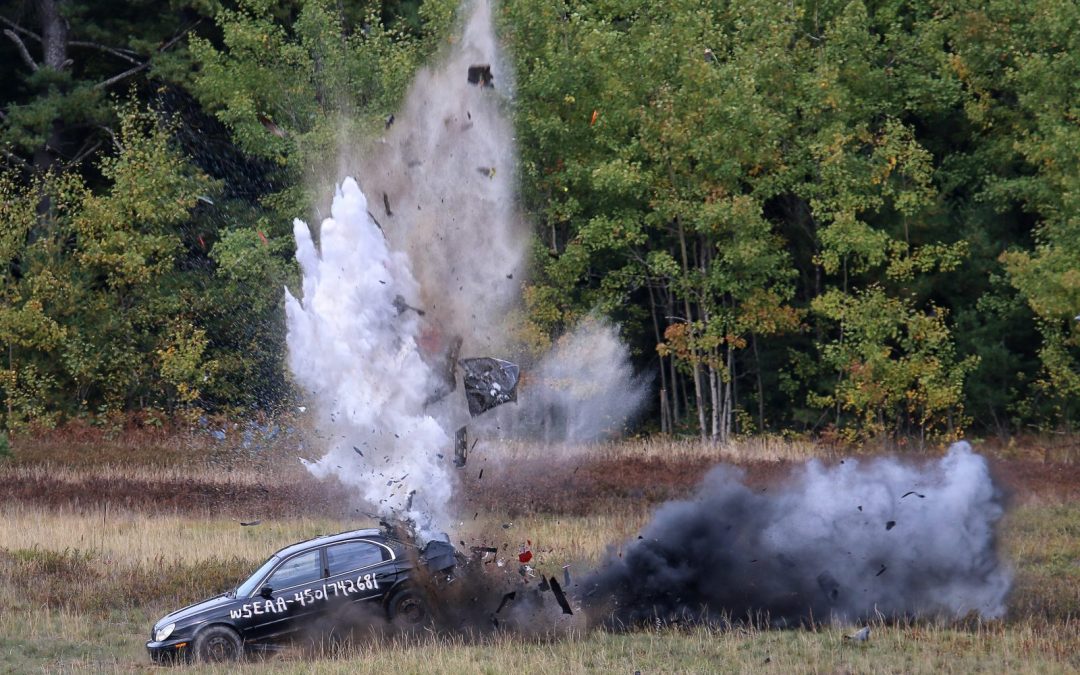Story and photography by Steve Bigg
Most people would think that in the world of explosive ordnance disposal and improvised explosive ordnance disposal (EOD/IEOD), there’s no better outcome to a mission than successfully disarming an explosive device.
But at the Canadian Forces (CF) multinational Counter Explosive Threat (CET) exercise, Ardent Defender, EOD/IEOD operators and related specialists from around the world gather to learn and develop not only the skills and drills necessary to disarm a bomb, but also to develop the abilities necessary to achieve their preferred mission outcome — stopping the bomb from being built in the first place.
There are many excellent EOD/IEOD exercises held annually around the globe — Ravens Challenge in the United States and Northern Challenge in Iceland, for example. These exercises are primarily designed to give EOD teams an opportunity to develop the tactics, techniques and procedures to safely accomplish EOD/IEOD operations.
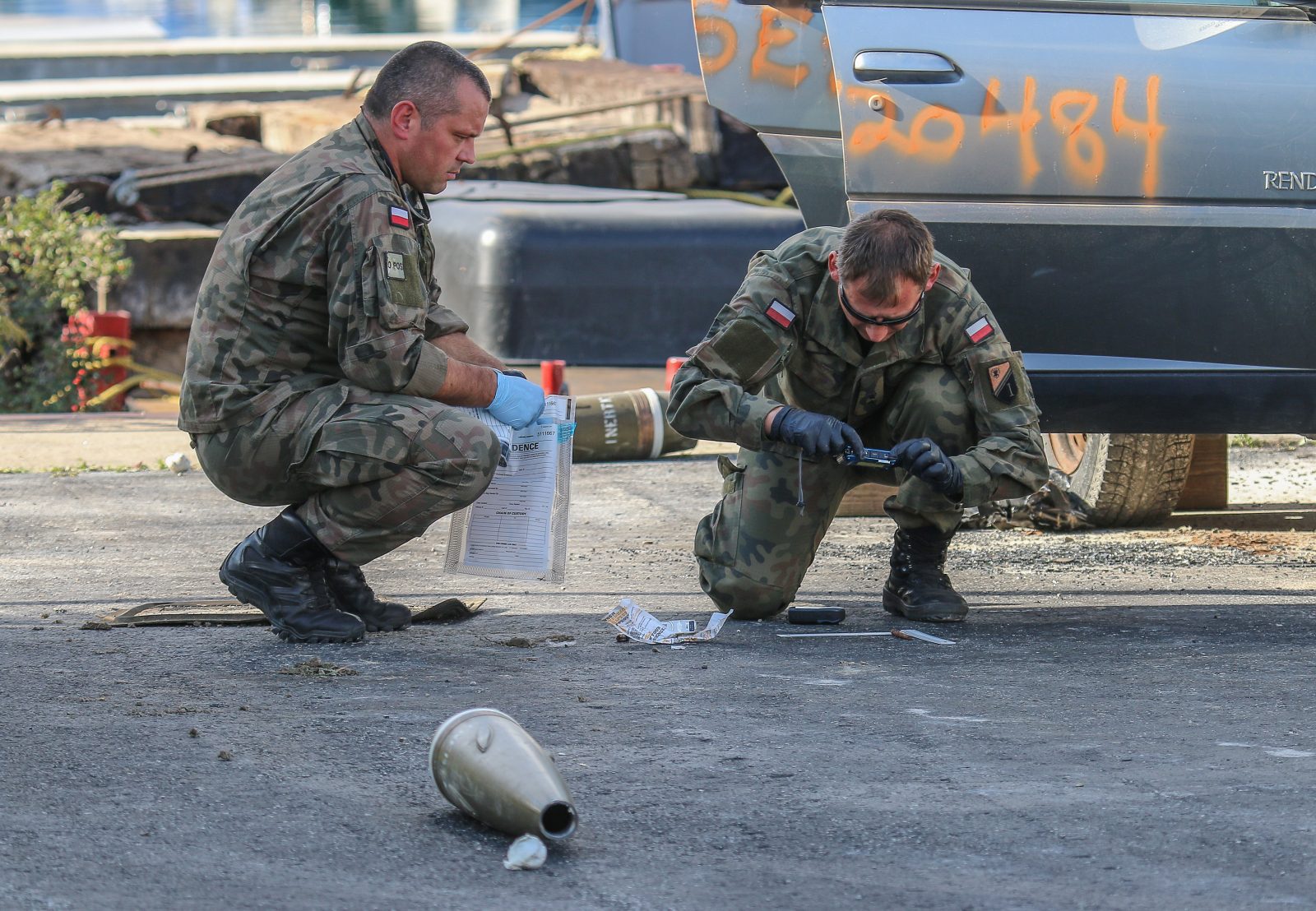
Working among the now dismantled components of a simulated IED, members of the Polish Army collect and document evidence from the scene for forensic analysis.
Ardent Defender certainly encompasses these same objectives. Bit it has evolved significantly over the six years it’s been running to go far beyond the work of EOD/IEOD teams. Lieutenant-Colonel Peter Peril is the deputy commander of the CF Joint Counter Explosive Threat Task Force (JCETTF) and director of exercise Ardent Defender. He explained the thinking behind the direction the exercise has taken.
“Instead of having to deal with the bomb, you want to find the guy that’s placing it; better yet you find the guy that built it; still better than that, you find the guy who educated the guy who built it and ideally the people who financed the operations that led to the bomb being in place.
“Usually, as you go further back, what you start to see are that many of those networks are linked to other activities like black markets, drugs, criminal activities, as well as opposing force elements. There are many nexuses that come together and the bomb is just what you see come out the bottom of all of that. That’s why we’ve evolved the exercise to move away from just focusing on the device and the EOD/IEOD teams and instead focus on the skills and abilities to get ourselves in a position where we’re dealing with the main problem that resulted in the device being in place.”
The process developed to achieve that goal is the Counter Explosive Threat Cycle. The cycle involves all the elements necessary to gather materials and intelligence, process them, and then analyze the information produced. The goal is to identify the people and/or organizations involved in making it possible for an explosive device to be become a threat and target those nodes to mitigate the threat before it affects freedom of movement for Canadian and allied troops.
The integration of those groups and their command and control elements, embedded with the full CET cycle, is what makes the structure of Ardent Defender unique among EOD exercises.
The success of developing the exercise in this direction is obvious from the long list of nations and organizations that participated in the 2018 iteration of the exercise, led by the JCETTF at Canadian Forces Base Borden and 4 Canadian Division Training Center Meaford between October 1-19. Beyond the involvement of all three arms of the Canadian Armed Forces, the list includes military and law enforcement branches of 25 nations.
Many have participated in past Ardent Defender exercises and return because of the results they see when they’re called out on actual operations.
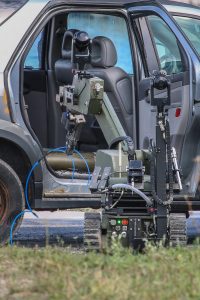
A tEODor EOD robot removes the components of a simulated IED from a vehicle.
“The lessons that they’re taking from here are being applied directly upon their operational deployment to ongoing missions,” said Peril. “For example, the CF unit that’s here now is preparing to deploy to operational theaters on the next rotation and replace the troops that are currently there. The units that are currently in theater trained on this exercise last year, so they are using the skills that they learned, the knowledge, the interoperability skills and relationships from this exercise on their current deployment. Now we’re regenerating that capacity for the next rotation.”
The first week of the exercise has two sides. While the EOD/IEOD teams are focused on force integration and training together to develop their skills outside of specific operational scenarios, the other elements of the CET cycle prepare for the tactical portion of the Ex., which takes place during weeks two and three.
Major Benjamin Chapman, the Officer Commanding, 13 C-IED Sqn, the EOD/High Risk Search Squadron of 1 Combat Engineer Regiment explained: “The two primary scenarios that the tactical portion of exercise will encompass are deliberate and on-call Quick Reaction Force (QRF) operations. Deliberate operations would be those that are planned in advance to identify an explosive threat through the employment of a Search Team and then conduct render-safe procedures with an EOD team. QRF operations are hasty in nature and are initiated when a patrol or other actor in the area of operations unexpectedly encounter a suspected IED or explosive threat; in this situation an EOD team will be called out to respond to the incident with limited time for planning and preparation.”
Both the deliberate and on-call scenarios are developed to take into account the goals of the participants as outlined far in advance during the pre-exercise planning conferences. Each organization involved in the CET cycle may understand the roles that are played by the other elements of the cycle, but at the exercise they’re given an opportunity to see those first-hand during the tactical and operational scenarios.
That results in a better understanding of the requirements others have to perform their specific function within the cycle. An EOD operator gains a deeper understanding of the intelligence that’s extracted from evidence gathered after a bomb has been disrupted if they actually see that evidence being analyzed and the information produced. Conversely, when someone on the forensic team witnesses a force protection unit work to keep an operator safe while gathering evidence, they may better understand the threat level involved and take this into consideration when making specific requests.
The learning extends far beyond any one nation’s specific goals. On operations, the teams that execute the overall CET cycle can be made up of multiple countries. Having the opportunity to work together during the exercise shows it’s true worth when participants are relying on each other in theatre. Working more effectively by being able to rely on established relationships and knowing the strengths and abilities of allies is a tangible benefit of participating in the exercise.
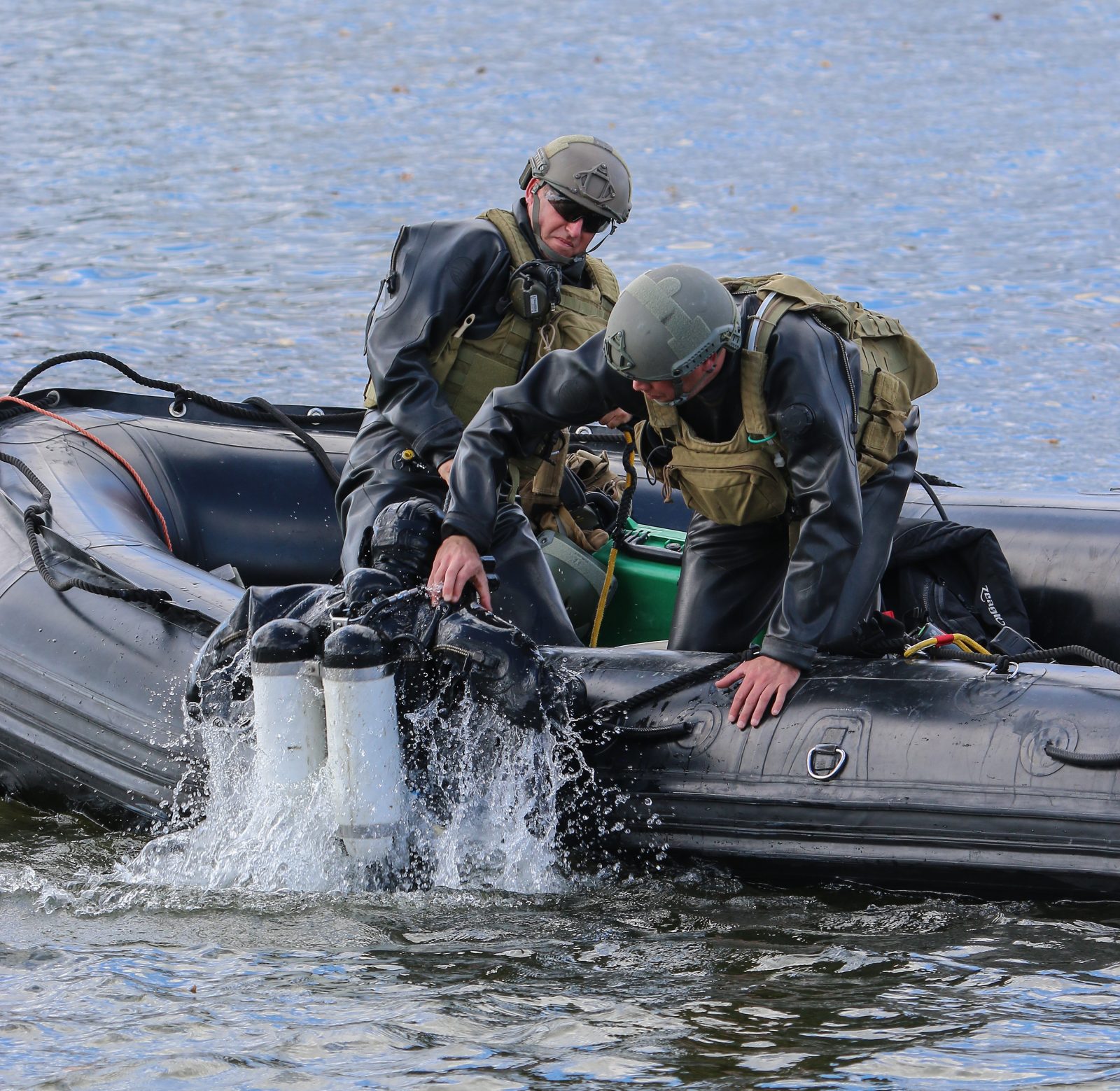
A Dutch Navy Special Forces diver is pulled aboard a boat by his team after inspecting docks and piers around the Coast Guard Search and Rescue Station.
The overall conflict scenario that Ardent Defender is built around is designed to roll out over a five-year period. The 2018 exercise was the second year of that conflict and each iteration builds on the efforts of the previous exercises.
This year, the participants are entering the scenario as Roto 2 in the conflict and will be able to benefit from the intelligence that was gathered during Roto 1. They also need to deal with any mistaken conclusions developed during the last exercise. All this gives them as realistic an experience of what they can expect when heading into an ongoing conflict as can be simulated. It also creates a more immersive atmosphere given participants know that the next “roto” will be relying on the CET cycle work they do now to build a picture of who the threats are.
That picture is built with information, said Peril. “At Ardent Defender, EOD technicians are trained to collect evidence with the intent of handing it into a forensic laboratory with the view of being able to identify patterns to do two things: First, that we understand the devices that are used in theatre so the technicians are more aware of the threats that they’re going to be facing and more prepared to deal with them; and, second, that we can look at the patterns of who’s building them, identify where the materials are coming from, the types of materials that are being used, so we can identify sources, supply chains, etc., to ideally identify who’s building and supplying them. The goal is to be able to break the chain at that point before the devices are put into the field where they impact our troops or the public.”
The collection of each physical piece of evidence from an incident site begins a chain of custody for that item that can ultimately end up in a court of law, leading to the conviction of persons responsible for the implementation of explosive devices. But there’s a lot of work to be done to get from the beginning to the end of that chain. And a lot of it is forensic work.
Major Donovan Rosser, an Australian Army Capability Manager, was focused on the analysis of explosive incident evidence at Ardent Defender this year. Rosser was interviewed in the Deployable Technical Analysis Laboratory (DTAL), a collection of container-like transportable labs for chemical, DNA, fingerprint and other technical analysis that connect together to provide a complete forensic test capability that can be deployed into theater.
He stressed the relevance of having this capability integrated with the exercise: “On the modern battlefield, forensics are absolutely critical. [A lot] of work that can be done in identity intelligence by taking the traces left by bomb-makers and other individuals of interest that they leave on the devices we recover. We can link all that together and with the right expertise, the right intelligence analysts and the right software, we can build a good picture. We can identify and find these people and prove that they are who we think they are, … [and] put them in jail.”
Having all the expertise and capability of the DTAL deployed into a theater provides an exceptional opportunity for the nation being assisted to learn.
“When we deploy, part of operations is to help educate and develop local forces, so they can continue sustaining stability and security in the nation once Canada and allied troops depart,” said Peril. “A major element of exercise Ardent Defender is to demonstrate and teach the procedures and skills needed to train other forces, building trust and residual enduring capacity.”

Forensic technicians inspect a bomb detonator with the hopes of producing evidence that will lead to identifying and prosecuting the bomb-maker and financial backer.
Bridging the gap between knowing how to do something and how to effectively teach it to someone else is one thing. But Peril explained that it doesn’t stop there. “Training someone how to deal with a problem is fine, but you also want to train them to be able to train themselves so that knowledge and skill can become a legacy that can carry on with in their own force once a situation has stabilized and we head home.”
On October 10, the third day of the tactical portion of Ardent Defender, the town of Meaford, Ont., became the focus of the exercise. A simulated bomb threat was called into the Canadian Coast Guard Search and Rescue Station located in the town’s harbor and the CET cycle moved into action. The scenario was designed to involve many of the assets available to the exercises EOD Coordination Center and to require integration with Meaford’s municipal organizations such as police, fire, EMS and government.
Once the threat evaluation was complete, the EOD team set to work to disrupt a bomb found in the back of a vehicle parked on the Coast Guard’s dock. Meanwhile, a team of Dutch Marine divers, with help from a Sûreté du Québec Police diver, searched in the water along the docks and around the Coast Guard ship to ensure more devices hadn’t been placed.
Once the Canadian team had disrupted the bomb and removed the primary elements from the car, an EOD technician suited up in the bomb suit and further inspected the vehicle to ensure it was safe for others to begin searching for evidence. Dutch Marines completed a detailed search of the car and the process of evidence collection and logging was started by a team from Poland.
By the time the evidence collected was processed through the DTAL and the information analyzed and evaluated, most of the nations and organizations participating in Ardent Defender had been involved in the scenario.
By the end of the exercise, they all had multiple opportunities to observe and learn from other participants, demonstrate and share their own abilities, and built relationships they will rely on in the future in real-world operations. And they’ll be better prepared for success in dealing with the threats they face in part due to their participation at exercise Ardent Defender.
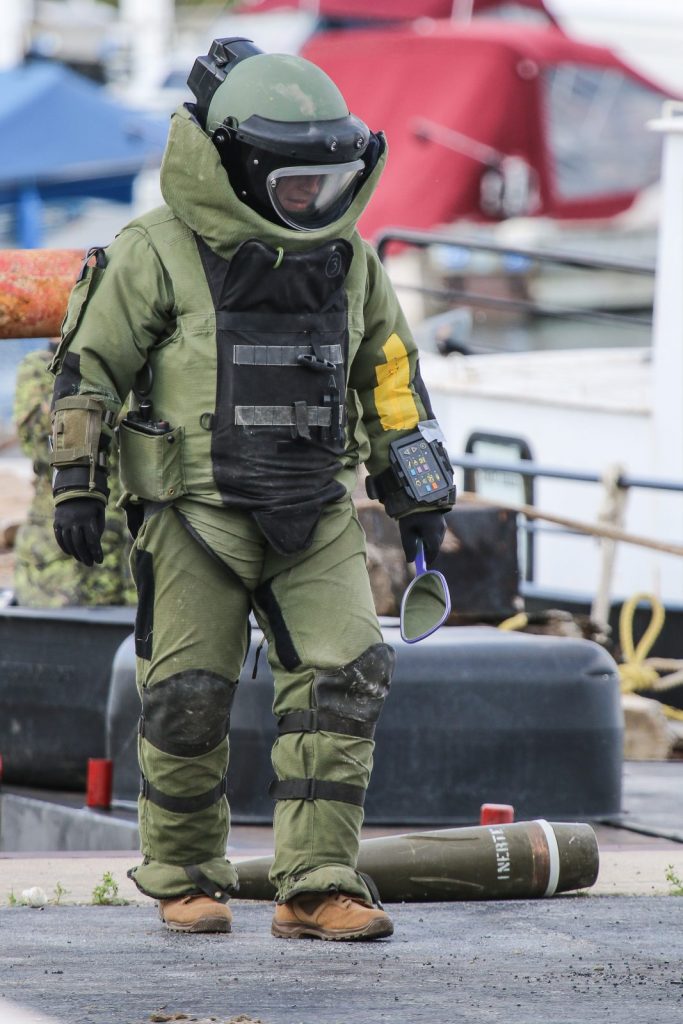
Wearing a bomb disposal suit, an EOD technician evaluates the scene where a simulated IED has been dismantled by a robot to confirm the threat has been removed and the evidence-gathering process can begin.
Ardent Defender 2018 Participant and Observer List
Canadian Armed Forces
Deployable Technical Analysis Laboratory
Canadian Army:
1 Combat Engineer Regiment
2 Combat Engineer Regiment
4 Engineer Support Regiment
5 Régiment du génie de combat
Royal Canadian Navy:
Fleet Diving Unit (Atlantic)
Fleet Diving Unit (Pacific)
Royal Canadian Air Force:
3 Wing (Bagotville, Quebec)
4 Wing (Cold Lake, Alberta)
8 Wing (Trenton, Ontario)
14 Wing (Greenwood, Nova Scotia)
Law enforcement
Ontario Provincial Police
Toronto Police Service
York Regional Police
Peel Regional Police
Niagara Regional Police
Sûreté du Québec
Swedish National Police
Federal Bureau of Investigation (United States)
Terrorist Explosive Device Analytical Center (United States)
Joint Deployable Exploitation and Analysis Lab (European Union)
International Participants
Australia
Austria
Belgium
Czech Republic
Columbia
Denmark
Greece
India
Israel
Italy
Mexico
Netherlands
New Zealand
Poland
Slovakia
Sweden
United Kingdom
Ukraine
United States
North Atlantic Treaty Organization Counter Improvised Explosive Devices Centre of Excellence
North Atlantic Treaty Organization Explosive Ordinance Disposal Centre of Excellence
Observer Nations
Chile
Germany
Latvia
Spain
Turkey
UAE


